Unlock Green Thumb: Tips That’ll Help Me Grow Weed Successfully
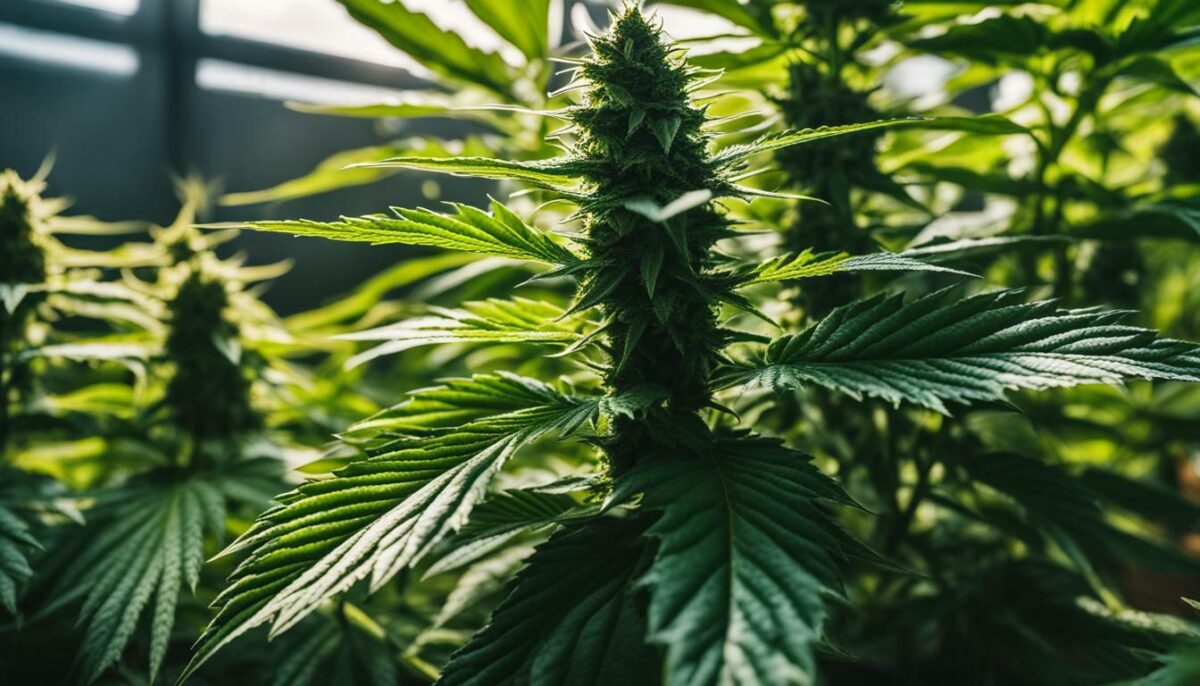
Growing marijuana plants can be a rewarding, albeit challenging, experience. As a beginner, it’s easy to get overwhelmed with all the information out there and feel unsure of where to start. But fear not! With the right guidance and a little bit of patience, anyone can develop a green thumb and successfully grow weed in any environment. In this guide, we’ll explore a comprehensive set of tips that will help you navigate the world of cannabis cultivation and set you on the path to success.
- Developing a green thumb takes patience and dedication.
- With the right guidance, anyone can successfully grow weed.
- Choosing the right seeds and creating the ideal growing environment are crucial steps.
- Properly managing growth, harvesting, curing, and storing are equally important.
- Expert tips and best practices can enhance your cultivation skills.
Choosing the Right Seeds: A Crucial Step in Growing Weed
Before diving into the world of cannabis cultivation, it’s crucial to choose the right seeds. Your choice of cannabis seeds determines the strain, genetics, and overall quality of your harvest. The first step in choosing the right seeds is to understand the different strains available on the market.
Cannabis strains are typically categorized as indica, sativa, or hybrid. Indica strains are known for their calming and relaxing effects, while sativa strains offer a more energizing and uplifting experience. Hybrid strains are a blend of both, offering a balance of effects. When choosing a strain, consider the desired experience and effects you’re looking for.
Another important factor to consider when choosing cannabis seeds is genetics. A high-quality cannabis seed should have stable genetics, ensuring consistent growth and characteristics. This is especially important for those looking to breed their own cannabis strains.
When it comes to finding the best cannabis seeds, it’s crucial to choose a reputable seed bank. One of the best USA seed banks is SeedsHereNow.com. With a wide variety of strains and guaranteed genetics, SeedsHereNow.com offers a reliable starting point for your grow.
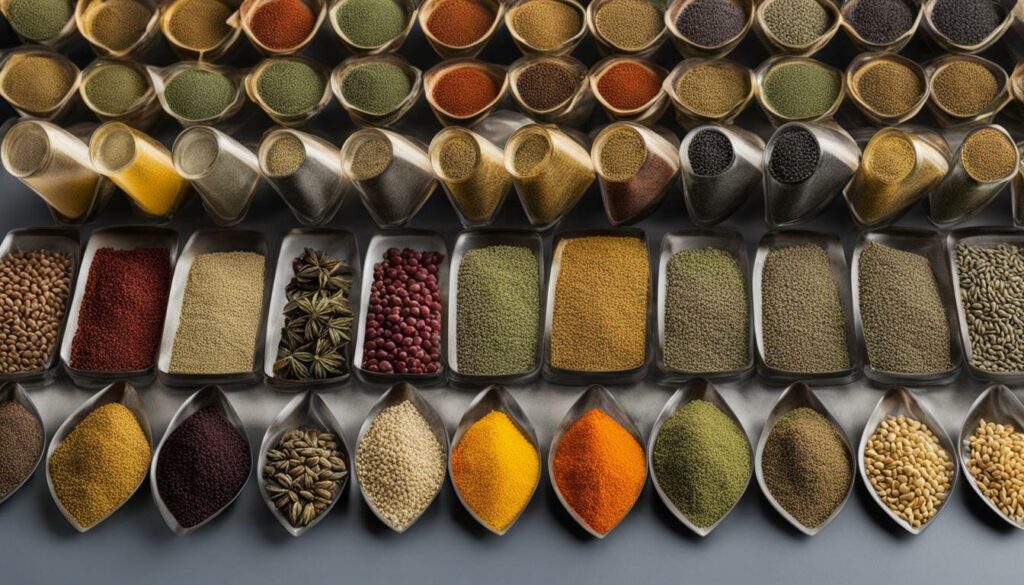
| Strain | Characteristics |
|---|---|
| Indica | Calming, relaxing effects |
| Sativa | Energizing, uplifting effects |
| Hybrid | Balance of effects |
Overall, choosing the right cannabis seeds is a crucial step in the growing process. By understanding the different strains, genetics, and choosing a reputable seed bank such as SeedsHereNow.com, you can ensure a successful and high-quality harvest.
Setting Up the Ideal Growing Environment
Creating the perfect environment for your cannabis plants is crucial for successful growth. A grow room is a designated space for cultivating cannabis plants, and setting it up requires careful consideration. Factors such as lighting, temperature, humidity, and airflow will impact the growth and overall health of your plants.
Lighting: One of the essential elements of a successful grow room is lighting. Cannabis plants require high-intensity light to grow, and inadequate lighting can negatively impact their growth. Consider investing in LED grow lights as they are energy-efficient and provide high-quality light that promotes optimal plant growth.
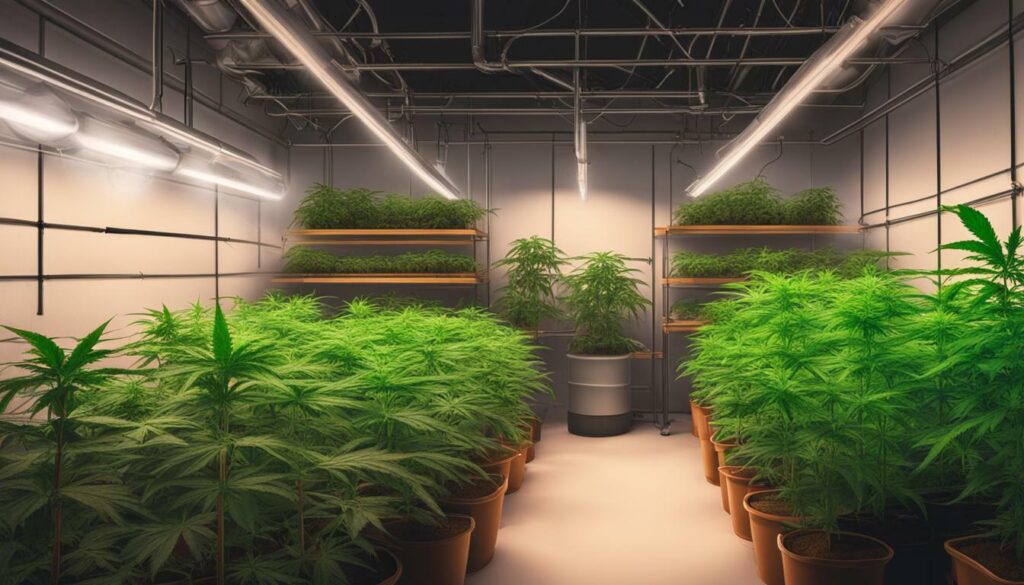
Temperature: The temperature in your grow room should be consistently maintained within a specific range for optimal growth. The ideal temperature range for cannabis plants is between 68-77°F during the day and 58-70°F at night. Any variation in temperature outside of this range can affect plant growth and photosynthesis.
Humidity: Maintaining proper humidity levels in your grow room is essential for healthy plant growth. The ideal humidity range for cannabis plants is between 40-60%. High humidity levels can cause mold and mildew, while low humidity levels can cause stress to the plants.
Airflow: Proper airflow in your grow room is essential for plant growth and preventing the buildup of harmful gases. Consider using fans or exhaust systems to ensure adequate airflow throughout the room.
Control Systems: Investing in control systems can help maintain optimal conditions throughout the growth stages. Products such as thermostats, hygrometers, and timers can help ensure consistent temperature, humidity, and lighting in your grow room to prevent any fluctuations that can negatively impact plant growth.
Nurturing Your Seedlings: The Seedling Stage
As a beginner, the seedling stage of your cannabis plants can be the most crucial. It’s essential to give your plants the best possible start to ensure healthy growth and a bountiful yield.
Start by using high-quality soil that allows for proper drainage and root development. It’s also important to water your seedlings correctly, using a spray bottle or gentle watering can to avoid overwatering and drowning the delicate plants.
As your seedlings grow, they’ll need proper nutrients to support their development. Consider using organic fertilizers or nutrient-rich soil to provide your plants with the necessary nutrients they need.
Light is also a critical factor in promoting healthy seedling growth. Provide your seedlings with ample light, whether through natural sunlight or grow lights, for at least 18 hours a day. This will help stimulate photosynthesis and encourage strong stem and leaf growth.
Remember to keep a close eye on your seedlings and adjust your care routine as necessary. With proper care and attention in the seedling stage, your cannabis plants will have a strong foundation for successful growth and a bountiful harvest.
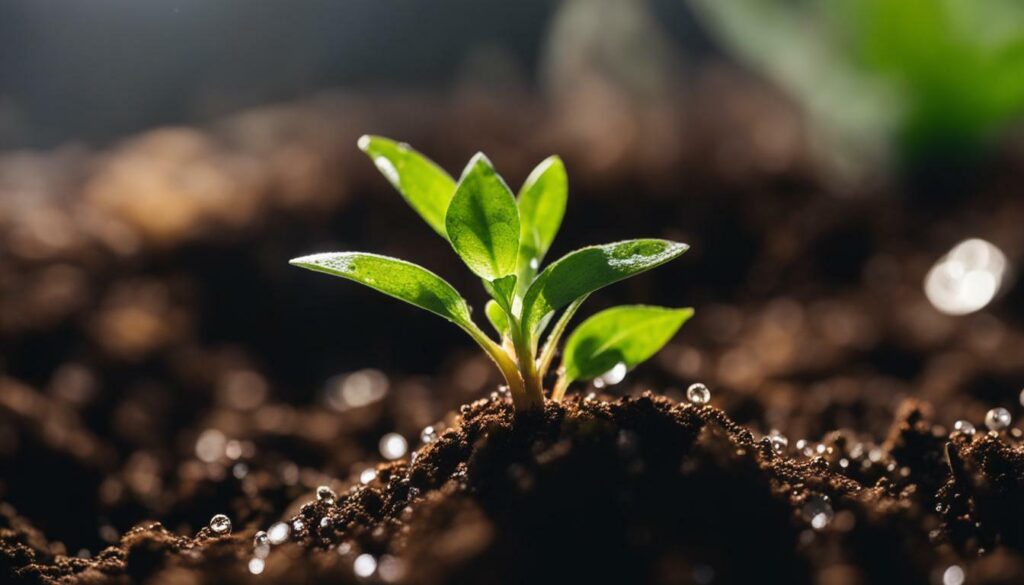
As your cannabis plants grow, they will pass through different stages of development. Understanding these stages and managing them appropriately is essential for achieving a successful harvest. The two primary stages in the life of a cannabis plant are the vegetative stage and the flowering stage.
The Vegetative Stage
The vegetative stage is the first stage of growth, beginning once the plant has sprouted and continuing until the plant begins to show signs of the flowering stage. During this stage, the plant’s primary goal is to develop a strong root system and grow as much foliage as possible. To support this, it’s crucial to provide the plant with adequate light, nutrients, and growing space.
Light is essential during the vegetative stage, and most growers prefer to use high-intensity discharge (HID) lights. It’s recommended to use a light cycle of 18-24 hours of light per day during the vegetative stage. Additionally, ensuring that the plant is receiving the right balance of nutrients, including nitrogen, phosphorus, and potassium, is crucial. Overfeeding or underfeeding can stunt growth and cause nutrient deficiencies or toxicities.
The Flowering Stage
The flowering stage is the second stage of growth, beginning once the plant has matured enough to start developing buds. During this stage, the plant’s primary goal is to produce flowers or buds, which contain the highest concentrations of THC and other cannabinoids. To support this, it’s crucial to manage the plant’s light cycle and nutrient intake.
During the flowering stage, the plant will require a different light cycle of 12 hours of light and 12 hours of darkness per day. This change in light cycle signals the plant to start producing buds. It’s also crucial to adjust nutrient intake during the flowering stage, reducing nitrogen and increasing phosphorus and potassium. This will support the development of healthy buds with high potency levels.
Overall, managing the growth stages of cannabis plants requires attention to detail and a willingness to adjust as needed. By understanding the vegetative and flowering stages and implementing appropriate light cycles and nutrient intake, you’ll be well on your way to a successful harvest.
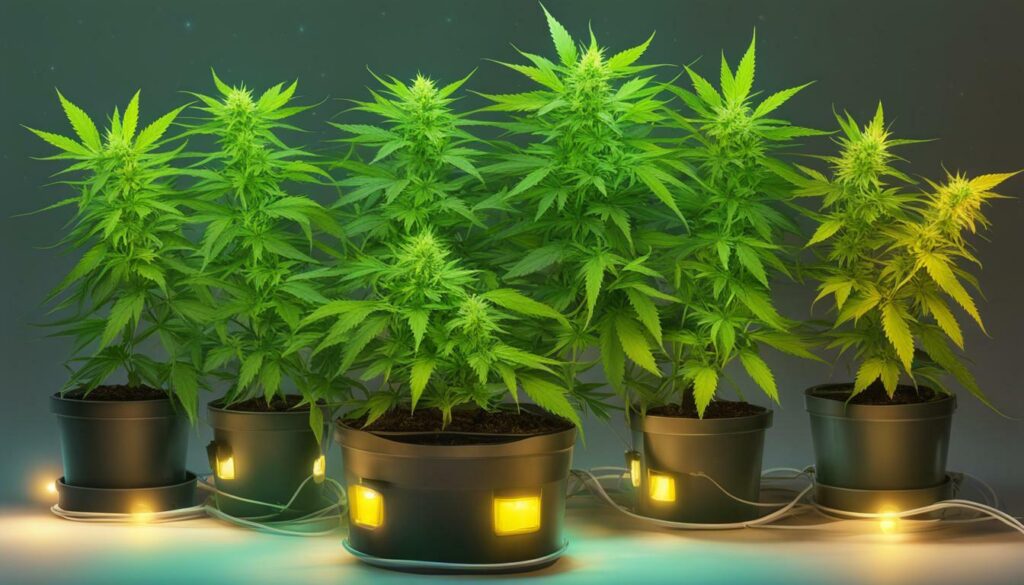
As my cannabis plants progress from the vegetative to the flowering stage, managing their growth becomes crucial. At this stage, the plants’ primary task is to produce buds, which will eventually be harvested. Therefore, it’s essential to provide them with the right environment and nutrients to thrive.
The first sign that the flowering stage has begun is the emergence of pistils – the tiny white hairs that appear at the node between the stem and branches. As the plant matures, these pistils will change color, indicating that the buds are reaching maturity.
Another crucial indicator of harvest readiness is trichomes – the tiny mushroom-shaped glands on the flowers that produce cannabinoids. To check trichome maturity, use a magnifying glass or a microscope. When the trichomes turn cloudy, it’s a sign that the buds are almost ready to harvest.
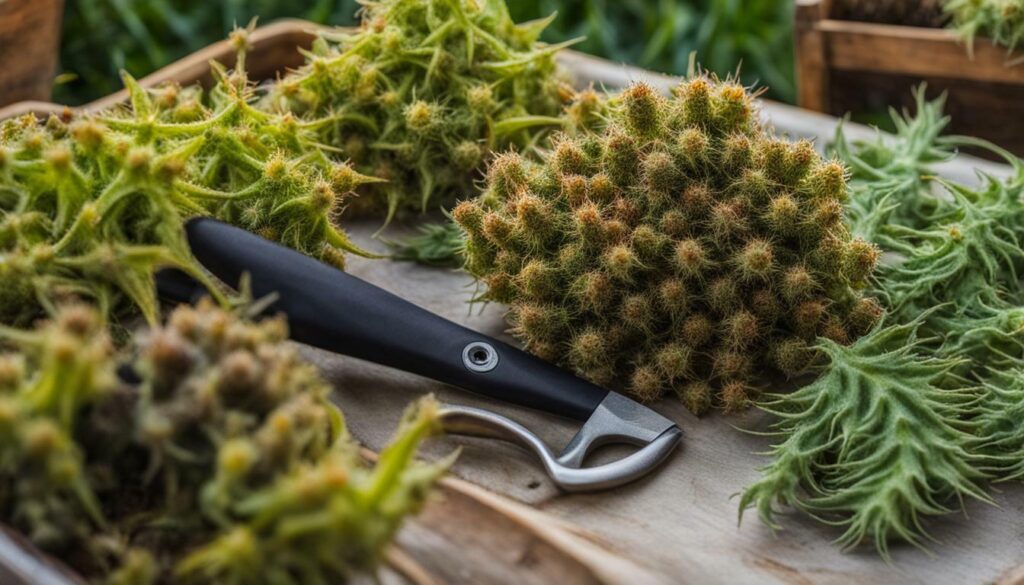
It’s also essential to monitor the plants’ nutrient requirements during this stage. As the buds grow, they will require increasing amounts of phosphorus and potassium. Therefore, it’s advisable to switch to bloom-specific nutrients at this stage, as they contain higher amounts of these minerals.
Finally, it’s important to maintain a consistent light cycle throughout the flowering stage. Most cannabis strains require a 12-hour light cycle to trigger flowering. However, some strains may require more or less light, so it’s crucial to research your specific strain to determine the ideal light cycle.
Curing and Storing: Preserving Your Harvest
After the exciting process of harvesting your cannabis plants, it’s important to properly cure and store your buds to maintain their potency and flavor. Curing refers to the process of drying and aging your buds, allowing them to develop their full flavor and aroma. Storing your buds properly is essential for preserving their freshness and preventing mold or mildew.
To begin the curing process, hang your trimmed buds upside down in a cool, dark room with good ventilation. After a few days, you can move them to airtight jars, filling the jars about 75% full. Burp the jars daily, opening them for a few minutes to release any excess moisture. This will help prevent mold and ensure the buds are properly curing.
When storing your cured buds, use glass jars with airtight seals to maintain proper moisture levels. Keep them in a cool, dark place, away from direct sunlight and heat. Avoid storing them in plastic bags, as this can lead to moisture buildup and mold growth.
Monitoring the moisture levels of your stored buds is crucial. You can use a hygrometer to measure the relative humidity inside the jar, aiming for a range of 58-62%. Higher humidity can lead to mold growth, while lower humidity can cause the buds to become brittle and lose their flavor.
Terpenes, the aromatic oils responsible for the unique flavor and smell of cannabis, can deteriorate over time if not stored properly. To preserve the terpene profile of your buds, avoid handling them excessively and store them in airtight jars.
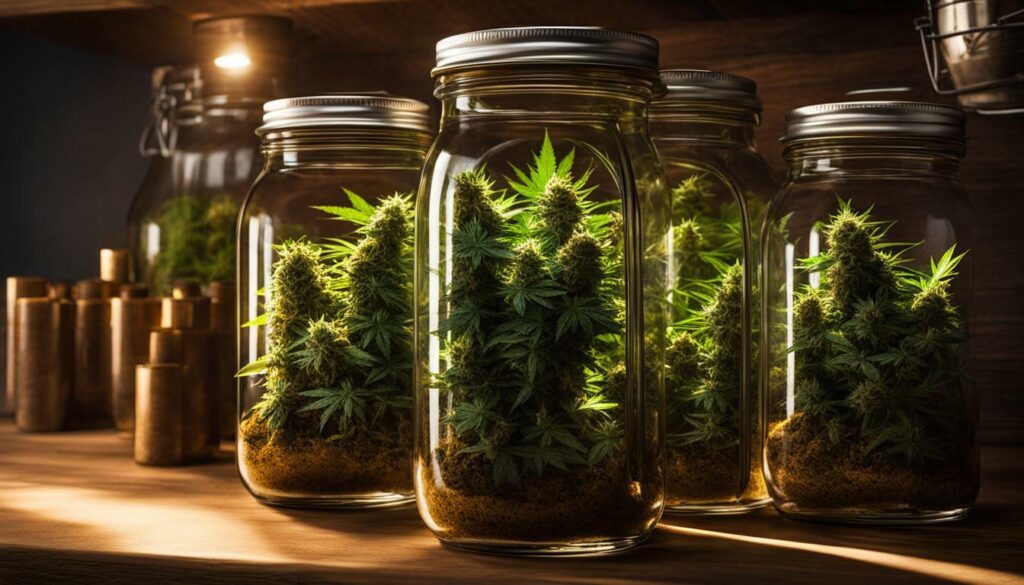
Storing your weed in the freezer can help maintain its potency and freshness for longer periods. Be sure to use airtight containers and avoid exposing the buds to sudden temperature changes when removing them from the freezer.
Troubleshooting Common Issues in Growing Weed
As a cannabis grower, it’s essential to be prepared for any challenges that may arise during the growing process. Here are some common issues you may encounter and tips on how to address them:
Mold
Mold can quickly become a serious problem for your cannabis plants, especially in humid environments. To prevent mold, ensure proper air circulation and keep humidity levels below 50%. If mold is already present, remove any affected plant material immediately and adjust the environment to prevent further growth.
Nutrient Deficiencies
If your cannabis plants are showing signs of yellowing leaves, stunted growth, or brown spots, they may be experiencing nutrient deficiencies. This can often be remedied by adjusting the pH levels of your soil or adding a nutrient-rich fertilizer to your watering routine.
Pests
Pests such as spider mites, aphids, and thrips can wreak havoc on your cannabis plants. Regularly inspect your plants for any signs of infestation, such as webbing or small insects. Consider using organic pest control methods, such as neem oil or insecticidal soap, to avoid chemical harm to your plants and yourself.
pH Levels
pH levels can greatly impact the growth and health of your cannabis plants. The ideal pH range for soil is 6.0-7.0, and hydroponic systems require a pH range of 5.5-6.5. Test your pH levels regularly and adjust as needed with pH adjusting solutions.
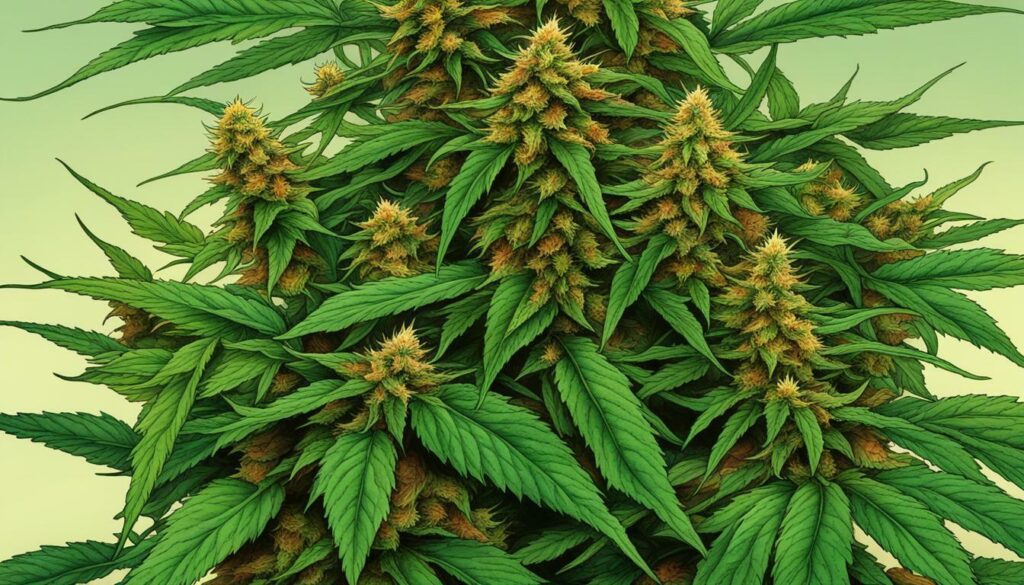
Remember, troubleshooting common issues in growing weed takes patience and attention to detail. By closely monitoring your plants and making adjustments as needed, you’ll be able to overcome any challenges that come your way.
Expert Tips and Best Practices for Growing Weed
As a novice cannabis grower, I am always on the lookout for expert tips and best practices to enhance my cultivation skills. Thankfully, there is an abundance of knowledge and experience available from top growers in the field. Here are some expert tips and best practices that I’ve gathered to help you improve your cannabis growth:
- Invest in quality seeds: Starting with the right seeds is crucial for successful growth. Make sure to choose high-quality cannabis seeds from a reputable source.
- Monitor pH levels: Keeping a close eye on the pH levels of your soil or water is essential to prevent nutrient deficiencies and maintain optimal plant health.
- Practice proper ventilation: Good airflow is essential for preventing mold and promoting healthy plant growth. Consider using fans or an air purifier to ensure proper ventilation in your grow room.
- Be patient: Growing cannabis takes time and patience. Avoid the temptation to rush the process and follow the necessary steps for each growth stage.
- Find the right growing medium: Whether you choose soil or hydroponic growing methods, finding the right growing medium is essential for healthy plant growth. Research the different options and find the one that works best for you.
- Stay organized: Keep track of your plant growth stages, nutrient schedule, and any issues that arise during the process. This will help you troubleshoot and make adjustments as needed.
- Learn from others: Join online communities or local grower groups to learn from experienced individuals in the field. This can provide valuable insights and tips for improving your growth.
By incorporating these expert tips and best practices into your cannabis cultivation, you can improve your yields and overall success as a grower. Remember, cannabis growth is an ever-evolving process, and there is always something new to learn!
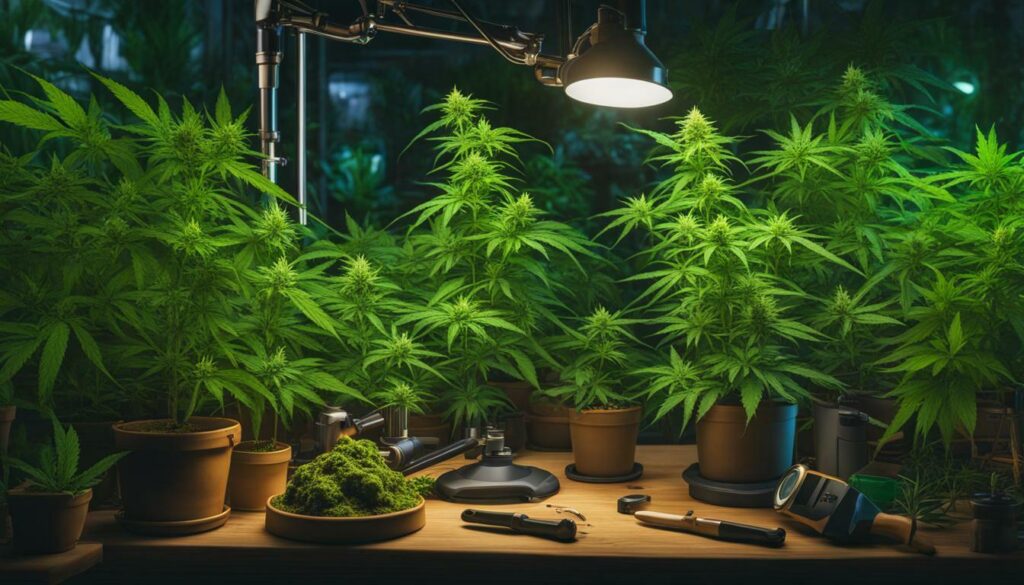
Choosing the right strain is a crucial step in growing weed. With so many strains available, it can be overwhelming to decide which one is the best fit for you. Understanding the differences between the three main categories: indica, sativa, and hybrid, can help.
Indica strains typically have a relaxing and sedative effect on the body. They are ideal for those looking to unwind after a long day, relieve pain, or sleep better at night. Indica strains tend to have more CBD, a non-psychoactive compound believed to have medicinal properties, than THC, the psychoactive compound responsible for the “high” feeling.
Sativa strains are known for their energizing and uplifting effects, making them ideal for daytime use. They can enhance focus, creativity, and sociability, making them popular for social events or creative pursuits. Sativa strains are typically high in THC and low in CBD.
Hybrids are a combination of both indica and sativa strains, offering a balance of effects. They can provide a relaxing body high with a cerebral, uplifting buzz, depending on the specific strain’s genetics. Hybrids can be indica-dominant, sativa-dominant, or evenly balanced.
Another factor to consider when choosing a strain is the effects you desire. Different strains can have different effects, such as increasing appetite, reducing anxiety, or improving mood. It’s crucial to research each strain’s effects and read reviews from other users before making a choice.
Finally, it’s essential to understand the impact of cannabinoids on each strain’s effects. THC and CBD are not the only cannabinoids present in cannabis; there are over 100 different cannabinoids, each with its unique effects. For example, CBG is believed to have anti-inflammatory properties, while CBN is known to promote sleep.
In conclusion, selecting the perfect cannabis strain for yourself can be a fun and exciting experience. Understanding the differences between indica, sativa, and hybrid strains, the various effects of different strains, and the role of cannabinoids can help make the decision-making process more manageable and effective.
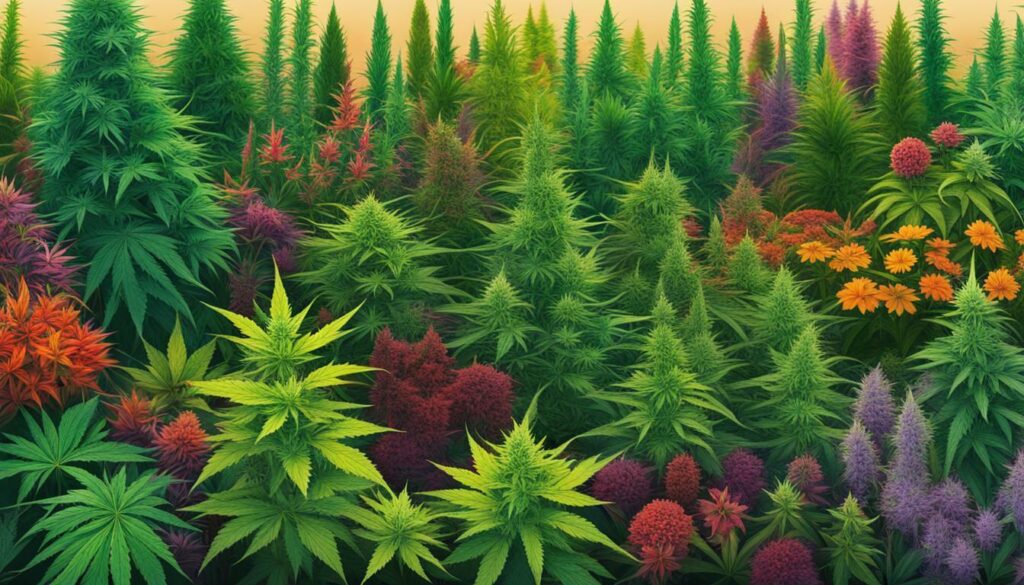
Conclusion: Growing Weed – A Rewarding Journey with Endless Possibilities
Growing weed is not just a hobby; it’s a rewarding journey that offers endless possibilities. It’s a chance to connect with nature, experience the satisfaction of nurturing plants to maturity, and enjoy the fruits of your labor. Throughout this guide, we’ve covered the crucial steps in growing weed successfully, from choosing the right seeds to harvesting your buds.
One of the most exciting aspects of growing weed is the endless possibilities it offers. With each grow, you can experiment with different strains, techniques, and equipment to refine your skills and achieve better results. It’s a journey of learning and discovery that will keep you engaged and motivated for years to come.
I hope that this guide has provided you with the knowledge and confidence to start your journey as a successful cannabis grower. Remember that it takes time, effort, and patience to master the art of growing weed. But with the right approach, the rewards are truly endless.
So take a deep breath, plant your first seed, and get ready to embark on a journey like no other. Growing weed is a rewarding experience that will give you a sense of accomplishment and satisfaction like no other. Welcome to the world of cannabis cultivation, and good luck on your journey!
Endless Possibilities Await
As you continue on your journey as a cannabis grower, remember that there are endless possibilities for experimentation, growth, and discovery. The cannabis plant is a truly remarkable organism, and every grow offers a chance to learn more about its complexities and potential.
From exploring different strains and genetics to experimenting with new nutrients and equipment, there’s always something new to discover in the world of cannabis cultivation. So embrace the journey, stay curious, and enjoy the rewards of growing weed. The possibilities are truly endless.
FAQ
Q: What are some tips for growing weed successfully?
A: To grow weed successfully, it’s important to choose the right seeds, set up the ideal growing environment, properly nurture seedlings, manage growth stages, harvest at the right time, cure and store your harvest, troubleshoot common issues, implement expert tips and best practices, and select the perfect strain for your desired experience.
Q: How do I choose the right seeds for growing weed?
A: When choosing seeds for growing weed, consider factors like strains, genetics, and the best seed banks. Look for reputable sources like SeedsHereNow.com, where you can find a wide range of high-quality seeds to kickstart your grow.
Q: What do I need to set up the ideal growing environment?
A: To create the perfect growing environment, focus on factors like proper lighting, temperature control, humidity levels, and airflow. Additionally, consider using control systems to maintain optimal conditions throughout the growth stages.
Q: How do I nurture seedlings during the early stages?
A: During the seedling stage, make sure to provide the right soil, adequate watering, essential nutrients, and sufficient light. Paying attention to these factors will help ensure healthy seedling development.
Q: How do I manage growth stages from vegetative to flowering?
A: As your plants transition from the vegetative to the flowering stage, it’s essential to adjust the light cycle, provide the proper nutrients, and monitor plant health. These measures will help manage growth and maximize yields.
Q: How do I know when it’s time to harvest my plants?
A: Keep an eye out for indicators of maturity, such as pistils and trichomes. When they reach the desired level of development, it’s time to harvest your plants for the best yields and potency.
Q: How do I properly cure and store my harvested buds?
A: After harvesting, follow proper curing techniques using jars and maintaining ideal moisture levels. This will preserve the potency, flavor, and terpene profile of your buds, ensuring a high-quality stash for later enjoyment.
Q: What are some common issues in growing weed and how can I troubleshoot them?
A: Common issues in growing weed include mold, nutrient deficiencies, pests, and pH level imbalances. Learn how to combat these problems effectively to maintain healthy plant growth throughout your cultivation journey.
Q: What are some expert tips and best practices for growing weed?
A: Gain valuable insights from experienced growers and implement their tried-and-true strategies. These tips and best practices will enhance your cultivation skills and lead to improved yields and overall success.
Q: How do I choose the right strain of weed for my desired experience?
A: Understanding the distinctions between indica, sativa, and hybrid strains, as well as the effects of different cannabinoids, will guide you in selecting the perfect strain to match your preferences and desired experience.
Q: What makes growing weed a rewarding journey with endless possibilities?
A: Growing weed offers a rewarding journey where you can unlock your green thumb and experience the satisfaction of cultivating your own high-quality cannabis. With dedication, knowledge, and a bit of trial and error, the possibilities are endless for creating a thriving garden.